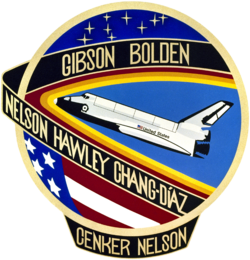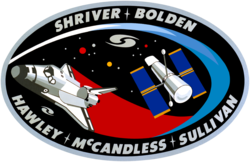Charles Bolden

Charles Frank „Charlie“ Bolden junior (* 19. August 1946 in Columbia, South Carolina) ist ein ehemaliger US-amerikanischer NASA-Astronaut und Generalmajor der Marineinfanterie. Von Juli 2009 bis Januar 2017 war er Administrator der NASA.
Ausbildung und Militärdienst
Bolden erhielt 1968 einen Bachelor in Elektrotechnik von der United States Naval Academy und 1977 einen Master in Systemmanagement von der University of Southern California.
1968 ging Bolden zum United States Marine Corps, wo er die Ausbildung zum Marineflieger durchlief. 1972 und 1973 flog er mehr als 100 Einsätze im Vietnamkrieg. Nach seiner Rückkehr war er Auswahl- und Rekrutierungsoffizier in Los Angeles und anschließend drei Jahre auf der Marine Corps Air Station in El Toro (Kalifornien) eingesetzt. Im Juli 1979 erhielt er seine Zulassung als Testpilot von der United States Naval Test Pilot School in Patuxent River (Maryland).
Astronautentätigkeit
| Charles Bolden | |
|---|---|
 | |
| Land | USA |
| Organisation | NASA |
| ausgewählt | 19. Mai 1980 (9. NASA-Gruppe) |
| Einsätze | 4 Raumflüge |
| Start des ersten Raumflugs | 12. Januar 1986 |
| Landung des letzten Raumflugs | 11. Februar 1994 |
| Zeit im Weltraum | 28d 8h 37min |
| ausgeschieden | 27. Juni 1994 |
| Raumflüge | |
Bolden wurde im Mai 1980 von der NASA als Astronautenkandidat ausgewählt.
STS-61-C
Bolden startete am 12. Januar 1986 als Pilot der Raumfähre Columbia zu seinem ersten Flug ins All. Hauptziel der Mission war es, den Kommunikationssatelliten SATCOM Ku-1 in seine Umlaufbahn zu bringen. Außerdem wurden zahlreiche kleinere astrophysikalische und materialwissenschaftliche Experimente durchgeführt.
STS-61-J
Diese aufgrund des Challenger-Unglücks abgesagte Atlantis-Mission STS-61-J hätte im Oktober 1986 das Hubble Space Telescope aussetzen sollen. Als Besatzung waren Kommandant John Watts Young (wäre sein 7. Start gewesen), Pilot Charles Bolden und die drei Missionsspezialisten Kathryn Dwyer Sullivan, Bruce McCandless und Steven Alan Hawley eingeplant. Die Mission wurde später STS-31.
STS-31
Boldens zweiter Flug – wieder als Pilot – begann am 24. April 1990. Hauptaufgabe von STS-31 war das Aussetzen des Hubble-Weltraumteleskops. Daneben wurden mit einer IMAX-Kamera Aufnahmen von der Erde gemacht. Die Discovery landete nach fünf Tagen am 29. April.
STS-45
Als Kommandant der Raumfähre Atlantis flog Bolden im Rahmen der ATLAS-1-Mission (Atmospheric Laboratory for Applications and Science) am 24. März 1992 ins All. Bei dieser Spacelab-Mission wurden Studien in den Bereichen Atmosphärenchemie, Sonneneinstrahlung, Plasmaphysik und Ultraviolettastronomie durchgeführt.
STS-60
Am 3. Februar 1994 startete Bolden zu seiner letzten Mission. Eine Besonderheit dieses Fluges war, dass mit Sergei Krikaljow zum ersten Mal ein russischer Raumfahrer mit einem amerikanischen Raumschiff flog. Die Wake Shield Facility und das Spacehab-Modul waren die Hauptnutzlasten an Bord der Discovery.
Nach der Astronautentätigkeit
Im Juni 1994 verließ Bolden die NASA und kehrte in den aktiven Dienst im US Marine Corps zurück. Im Juli 1998 wurde er zum Generalmajor befördert. Am 9. August 2002 schied er aus dem Marine Corps aus und wurde im Januar 2003 von der American Puretex Water Corporation und PureTex Water Works als Präsident und Chief Operating Officer angestellt. Drei Monate danach endete das Anstellungsverhältnis.[1]
Am 20. Mai 2009 wurde er von Präsident Barack Obama für den Posten des NASA-Administrators und Lori Garver als seine Stellvertreterin nominiert.[2] Am 15. Juli 2009 wurde Bolden durch den Senat als NASA-Administrator und Nachfolger von Michael Griffin bestätigt. Diese Aufgabe übte er bis zum 19. Januar 2017 aus.
2020 wurde Bolden in die National Academy of Engineering gewählt.
Privates
Charles Bolden und seine Frau Alexis haben zwei Kinder.
Siehe auch
Literatur
- Charles Bolden in: Internationales Biographisches Archiv 37/2009 vom 8. September 2009, im Munzinger-Archiv (Artikelanfang frei abrufbar)
Weblinks
- Kurzbiografie von Charles Bolden bei spacefacts.de
- NASA-Biografie von Charles Bolden (englisch; PDF)
- Biografie von Charles Bolden in der Encyclopedia Astronautica (englisch)
- Charles Bolden's Story: "From the Segregated South to Low Earth Orbit"
Einzelnachweise
- ↑ Monica Perin: Firm hopes water demand runneth over. Houston Business Journal, 18. Juli 2004, archiviert vom am 3. Juni 2014; abgerufen am 15. März 2024 (englisch). Info: Der Archivlink wurde automatisch eingesetzt und noch nicht geprüft. Bitte prüfe Original- und Archivlink gemäß Anleitung und entferne dann diesen Hinweis.
- ↑ FliegerRevue Juli 2009, S. 9, Charles Bolden wird neuer NASA-Chef
| Personendaten | |
|---|---|
| NAME | Bolden, Charles |
| ALTERNATIVNAMEN | Bolden, Charles Frank junior (vollständiger Name); Bolden, Charlie junior (Spitzname) |
| KURZBESCHREIBUNG | US-amerikanischer NASA-Astronaut und Generalmajor der Marineinfanterie |
| GEBURTSDATUM | 19. August 1946 |
| GEBURTSORT | Columbia, South Carolina |
Auf dieser Seite verwendete Medien
Official portrait of Astronaut Charles F. Bolden Jr. wearing an orange launch and entry suit.
Major General Charles F. Bolden, Jr
STS-60 crew patch
- The design of the crew patch for NASA's STS-60 mission depicts the Space Shuttle Discovery's on-orbit configuration. The American and Russian flags symbolize the partnership of the two countries and their crew members taking flight into space together for the first time. The open payload bay contains: the Space Habitation Module (Spacehab), a commercial space laboratory for life and material science experiments; and a Getaway Special Bridge Assembly in the aft section carrying various experiments, both deployable and attached. A scientific experiment to create and measure an ultra-vacuum environment and perform semiconductor material science – the Wake Shield Facility – is shown on the Remote Manipulator System (RMS) prior to deployment.
STS-45 Mission Insignia
STS-61-c mission patch
- Columbia, which opened the era of the Space Transportation System with four orbital flight tests, is featured in re-entry in the emblem designed by the STS-61C crew representing the seven team members who manned the vehicle for its seventh STS mission. Gold lettering against black background honors the astronaut crewmembers on the delta pattern surrounding colorful re-entry shock waves, and the payload specialists are honored similarly below the sphere.
STS-31 shuttle mission flight insignia. The mission insignia for NASA's STS-31 mission features the Hubble Space Telescope (HST) in its observing configuration against a background of the universe it will study. The cosmos includes a stylistic depiction of galaxies in recognition of the contribution made by Sir Edwin Hubble to our understanding of the nature of galaxies and the expansion of the universe. The STS-31 crew points out that is it in honor of Hubble's work that this great observatory in space bears his name. The depicted Space Shuttle trails a spectrum symbolic of both the red shift observations that were so important to Hubble's work and new information which will be obtained with the HST. Encircling the art work, designed by the crew, are the names of its members.







